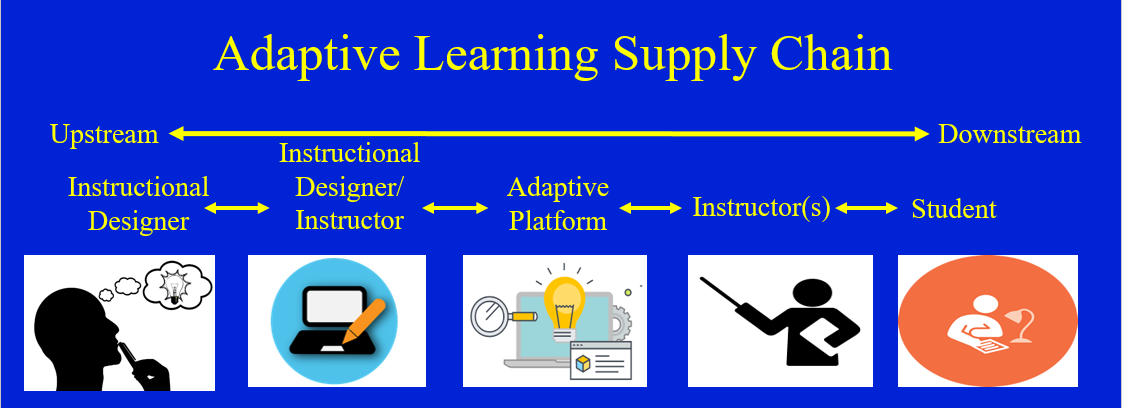Supply Chain Management and Adaptive Learning

There is an adage that there is nothing new under the sun. However, often, dissimilar terminology, contexts and time frames obscure commonalities in theories and problem solutions. For example, Steven Johnson (2005) in his book, “Everything Bad is Good for You” argues that video games that are too easy or difficult for players will cause them to disengage very quickly. He contends that the proper balance between difficulty and reinforcement keeps gamers motivated. What he describes resonates with Vygotsky’s (1978) zone of proximal development for effective learning framed with proper levels of tension and achievement. Although postulated in different time frames the two concepts intersect, reinforce and validate each other. To our knowledge, however, Johnson does not reference Vygotsky, who proceeded him by almost three decades.
There are other examples. In physics, for instance, the law of space and time translation symmetry (Wilczek, 2019) shows that no matter where or when a physical principle is evaluated it will remain constant – it is invariant. There is a corollary in education, psychology, natural science and medicine where robustness of findings become a high-value proposition. Most often that stability emerges through meta analytic methods (Cooper, Hedges & Valentine, 2019) identifying effect sizes that are independent of time, context and discipline. One is a physical law and the other is a research method; however, the desired outcome is the same: robustness. One more example reinforces our point. There is a theory in economics called the yard sale model (Boghosian, 2019) that demonstrates a breaking of symmetry in free-market economies, causing wealth to flow from the poor to the rich. This wealth advantage, sometimes called the Mathew Effect (Saleh & Sanders, 2014), has a clear analogy in educational attainment, where educational opportunity in underserved neighborhoods restricts college access, thereby asymmetrically limiting financial opportunity. In this example, an economic theory of wealth distribution bares a direct relationship to effective educational practice.
There are many other examples. However, our point is that what appear to be independent lines of investigation at first blush are closely aligned. Unfortunately, however, it is all too rare for cross-discipline conversations to occur even in this age of electronic communication. Even more importantly, it is highly likely that our bright new idea has seen the light of day in the recent or even the distant past. For example, adaptive learning and supply chain management have fundamentally similar theoretical underpinnings and structural elements. Consider the following examples.
The Supply Chain
Since its inception in the early 1980s, the term “supply chain” has had many interpretations, but a commonly accepted definition is a group of companies that pass information, products, services, and funds up and down the chain (Cooper, Lambert, & Pagh, 1997; Lambert, Stock, & Ellram, 1998; Mentzer & Mentzer, 2001). The process is chiefly built and operated on trust among the firms that are contributing members of the partnership. The figure above illustrates an example of a typical supply chain.

When demand for products or services increases or decreases, these changes reverberate through the entire system. For example, if demand for a product begins to decline, then the amount of raw materials sourced by suppliers must decrease, reducing inventory levels at each stage. However, if demand increases, then additional product must be sourced, produced, shipped, and inventoried throughout the system. Both situations help ensure there are enough goods to meet the demand of the consumer.
Parallel Elements in Adaptive Learning
In the figure below we circle back to our introduction about intersecting disciplines. Adaptive learning (Carroll, 1963) features three guiding principles that resonates with supply chain management; it personalizes the educational experience, customizes content and assesses continuously. The implementation of these principles in the educational environment requires functional elements that corresponded to those of supply chain management. The instructional designer is the surrogate supplier, who works in conjunction with the instructor to emulate the manufacturer. The adaptive platform pairs with the distributer. Instructors are the knowledge and learning retailers and students become the customers.

The table below demonstrates the correspondence of the elements of supply chain management with those of adaptive learning:
| Supply Chain Management | Adaptive Learning |
|---|---|
| Supplier Responsible for sourcing materials at a good price, sufficient quality and providing these materials to a manufacturer who will then produce the product. | Instructional Designer The Learning Content and Curriculum are the raw materials of learning. The Instructional Designer (ID) is responsible for the creation and quality of these. |
| Manufacturer Responsible for producing the product from the raw materials sourced and delivered by the supplier. They also design, package and label the product prior to being placed on the market. | Instructional Designer / Instructor The Program or Course organizes the raw materials into a product that can be consumed by the end user, the learner. The ID and instructor are responsible for packaging the right raw materials together to match the requirements and needs of the learners. |
| Distributor/Wholesaler Responsible for connecting the manufacturer to the customer. They deliver the right products, in the required quantities, at the correct time, and in the condition desired by the customer. | Adaptive Platform The adaptive platform is responsible for taking the contents of the program/course and delivering the appropriate learning at the right time for each individual student. |
| Retailer Responsible for selling product or service directly to the customer. They are also the direct point of contact between a firm and the customer and are in the best position to know and collect the customer’s needs. | Instructor The human point of contact between the learning and the learner. The instructor is in the position to interact directly with the student and ensure their learning needs are being met. |
| Customer Responsible for the purchase of the product or service. This segment provides valuable feedback which enables the firm to better the product or service they offer. | Student The end consumer in the learning process. Explicit feedback from the students, along with their learning data gathered by the adaptive platform, enable the improvement of the alignment between the learning products and the student needs. |
Two Case Studies
Amazon Fulfillment Center
A firm’s supply chain can be enhanced by technology and automation. Integration of logistical systems, robotics, warehouse conveyor systems, enterprise resource planning software, etc., all have the goal of improving delivery times to customers and enabling real-time visibility throughout the supply chain. A company that exemplifies the use of technology and automation is Amazon at their fulfillment centers.
Amazon fulfillment centers use thousands of robots that perform many repetitious jobs that humans could do but would not generally enhance proficiency and potentially experience long-term physical consequences. This type of automation, however, does not replace people per se. Strategically the company will use and cross train this available workforce in other areas of their facilities (inbound, outbound, packing, etc.). This forward thinking enables the company to fill in scheduling gaps during peak and non-peak seasons.
Amazon’s mixture of humans and robots has proven that people, no matter how much automation is present, will always be tasked with making on-the-spot business decisions for the company.
Adaptive Learning
In many areas, people have begun to take advantage of computers and artificial intelligence to automate some aspects of their tasks. The key idea is to take the components of that job that each is most proficient at, and work in partnership to realize previously unachievable results. The Amazon fulfillment centers are excellent examples.
Several recent examples of this are detailed in the recent book by Hannah Fry (Fry, 2018). One focuses on the field of medicine, where pathologists search for cancerous cells within biopsies requiring processing of a huge quantity of information in a single slide. This is arduous and tiring work that can lead to human error. Recent advances in AI approaches allow computers to quickly identify anomalous groups of cells in a slide; however, they regularly flag healthy cells, something that a pathologist rarely does. Combining the power of the computer with the accuracy of the human expert allows the affordances of both to be used. As stated in the book, “The algorithm never gets tired and the pathologist rarely misdiagnoses. The algorithm and the human work together in partnership, exploiting each other’s strengths and compensating for each other’s flaws.”
Another example in the book comes from the world of chess. After chess grandmaster Garry Kasparov was famously beaten by the supercomputer Deep Blue in 1997, he turned his attention to a version of the game known as Centaur Chess, where a human player and an algorithm work in collaboration with each other as a hybrid team, each focusing on their own strengths. The human is in charge and dictates the strategic plan; the computer works on assessing the consequence of all possible moves, reducing the chance of error. This frees the humans from the calculation task and allows them to be more creative. Kasparov has stated that “when playing with the assistance of computers, we can concentrate on strategic planning instead of spending so much time on calculations. Human creativity was even more prominent under these conditions (GenPact, 2018).”
Adaptive Learning also seeks to take advantage of data, AI and automation. The goal is not to replace the role of the instructor but to remove the burden of tasks that can be automated, such as the creation of assessments, and to allow the implementation of options that would not be feasible with a single instructor, such as allowing students to follow personalized pathways and move at their own pace. This frees the instructor to concentrate on areas that the machine will never be capable of doing as effectively, such as interacting with students.
Finally
Both supply chain management and adaptive learning, although contextually different, constitute similar autocatalytic systems that feature responsiveness to the needs of their respective clientele. In both approaches a change in consumer demand or student accomplishment ripples through each framework, causing the elements in the table above to adjust – sometimes incrementally or in other instances more dramatically. Consistent feedback makes both systems dynamic.
Both integrate human performance, and technology redefines the roles of employees, students and teachers. Both incorporate machine learning such as artificial intelligence, or possibly Bayesian decision algorithms. Both have potential for providing solutions for societal problems beyond their immediate spheres of influence. A prime example is quality of life for educationally and economically underserved populations by providing access to not only quality goods and services at reasonable prices but educational opportunity as well.
Therefore, those professionals working on the supply chain side can inform adaptive learning systems by providing insights into effective practices and difficult issues in the chain. Conversely, those educators working in adaptive learning can offer insights to their colleagues in business about how effective learning and information sequencing can improve their processes. This seems reasonable because the remarkable similarities in the two systems indicate that the supply chain of products and information have originated from the same thought process.
References
- Boghosian, B.M. (2019, November). The inescapable casino. Scientific American, 321(5), 71-77.
- Carroll, J. B. (1963). A model of school learning. Teachers College Record, 64, 723-733.
- Cooper, M. C., Lambert, D. M., & Pagh, J. D. (1997). Supply Chain Management: More Than a New Name for Logistics. The International Journal of Logistics Management, 8(1), 1-14.
- Cooper, H., Hedges, L.V. & Valentine, J.C. (2019). The handbook of research synthesis and meta-analysis. New York, NY: Sage.
- GenPact. (2018). Don’t underestimate importance of process in coming world of AI. Retrieved from http://www.genpact.com/ insight/ blog/ dont-underestimate-importance-of-process-in-coming-world-of-ai.
- Fry, Hannah (2018). Hello World: Being Human in the Age of Algorithms (1st ed.). New York, NY: W. W. Norton & Company.
- Johnson, S. (2005). Everything bad is good for you: How today’s popular culture is actually making us smarter. New York, NY: Riverhead Books.
- Lambert, D. M., Stock, J. R., & Ellram, L. M. (1998). Fundamentals of logistics management. Boston, MA: Irwin/McGraw-Hill.
- Mentzer, J. T., & Mentzer, J. T. (2001). Supply chain management. Thousand Oaks, CA: Sage Publications.
- Saleh, A., & Sanders, H. (2014). The wolf in sheep’s clothing: The Matthew effect in online education. Revista Internacional de Sociología de la Educación, 3(1), 26-50.
- Vygotsky, L. S. (1978). Mind in society: The development of higher psychological processes. Cambridge, MA: Harvard University Press.
- Wilczek, F. (2019, November). Crystals in time. Scientific American, 321(5), 28-35.



